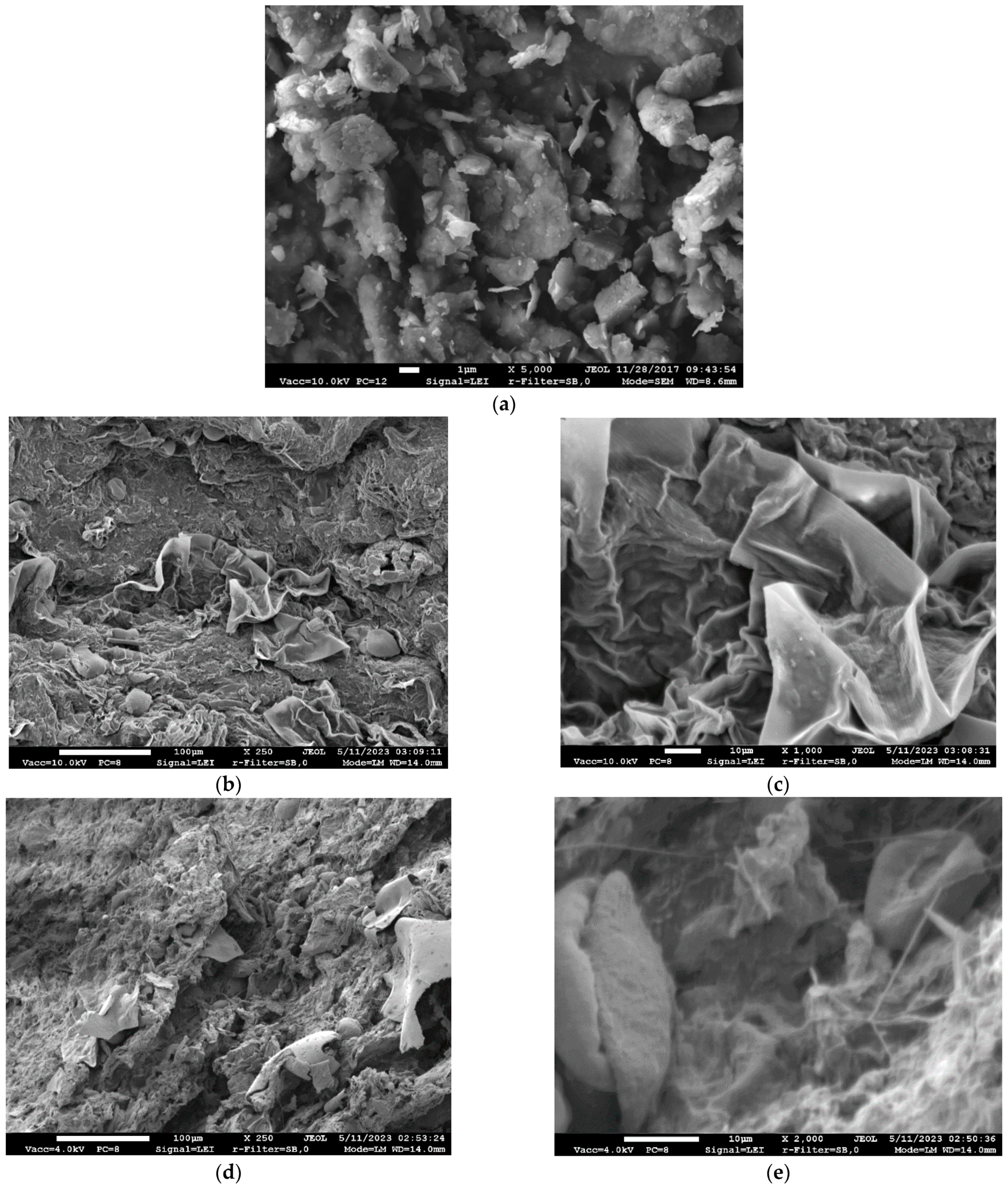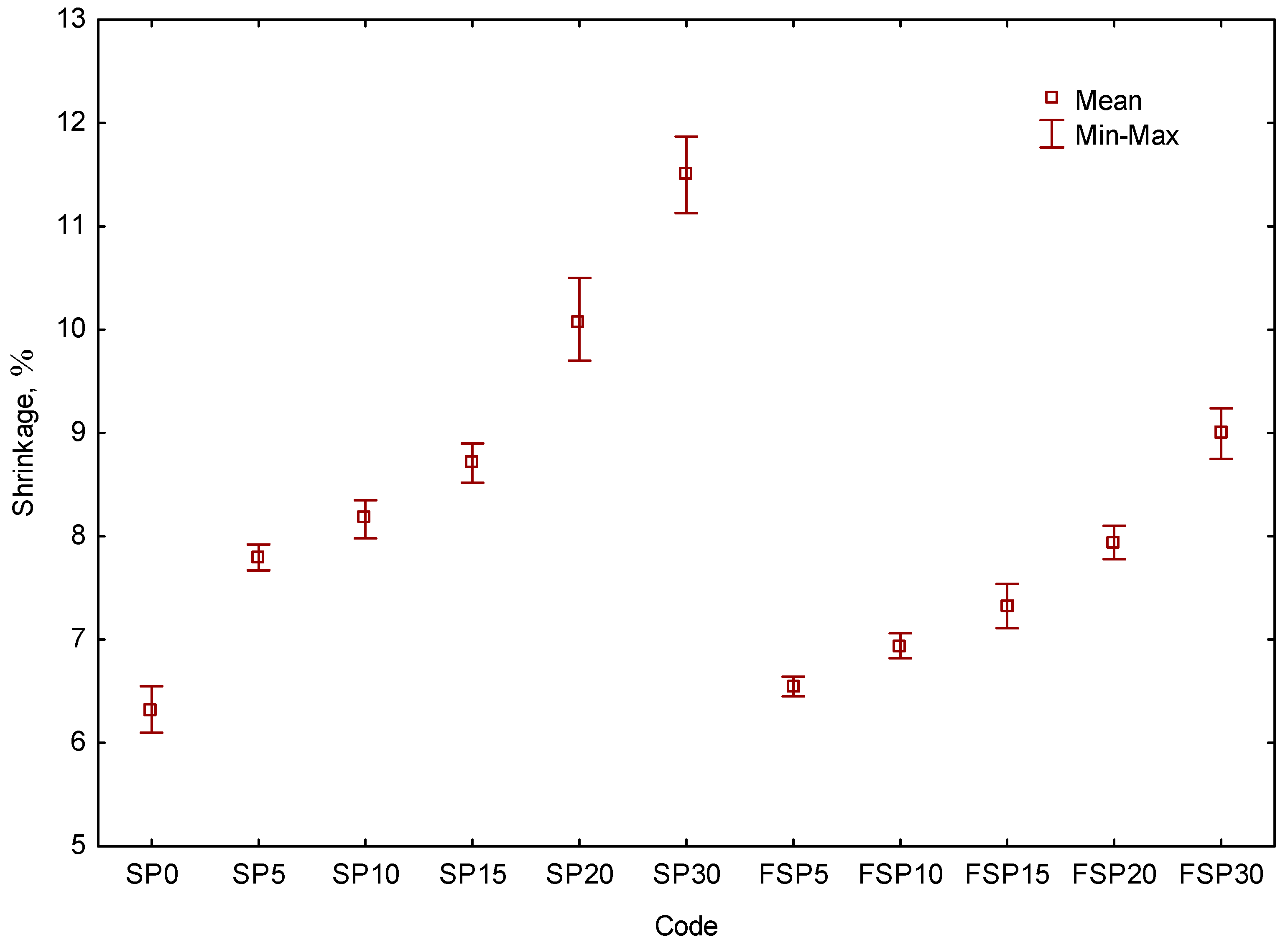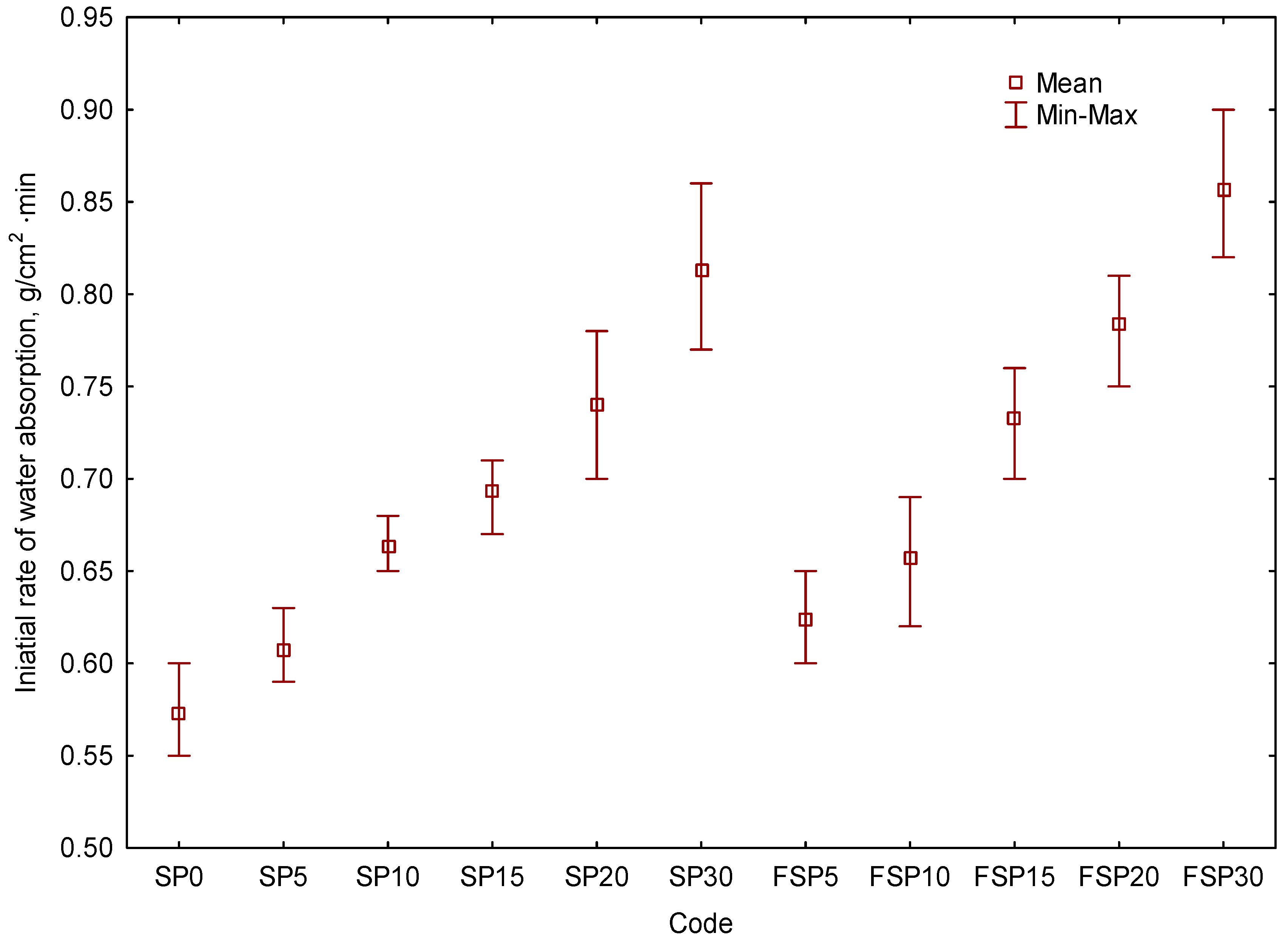The Effect of Organic Lake Sediments (Sapropel) on the Properties and Biological Resistance of Unfired Clay Bricks
Abstract
:1. Introduction
2. Materials and Methods
2.1. Materials
2.2. Methods
3. Results and Discussion
4. Conclusions
Author Contributions
Funding
Institutional Review Board Statement
Informed Consent Statement
Data Availability Statement
Conflicts of Interest
References
- Murmu, A.L.; Patel, A. Towards sustainable bricks production: An overview. Constr. Build. Mater. 2018, 165, 112–125. [Google Scholar] [CrossRef]
- Salim, R.W.; Ndambuki, J.M.; Adedokun, D.A. Improving the Bearing Strength of Sandy Loam Soil Compressed Earth Block Bricks Using Sugercane Bagasse Ash. Sustainability 2014, 6, 3686–3696. [Google Scholar] [CrossRef]
- Ashour, T.; Korjenic, A.; Korjenic, S.; Wu, W. Thermal conductivity of unfired earth bricks reinforced by agricultural wastes with cement and gypsum. Energy Build. 2015, 104, 139–146. [Google Scholar] [CrossRef]
- Obonyo, E.; Exelbirt, J.; Baskaran, M. Durability of Compressed Earth Bricks: Assessing Erosion Resistance Using the Modified Spray Testing. Sustainability 2010, 2, 3639–3649. [Google Scholar] [CrossRef]
- Muheise-Araalia, D.; Pavia, S. Properties of unfired, illitic-clay bricks for sustainable construction. Constr. Build. Mater. 2021, 268, 121118. [Google Scholar] [CrossRef]
- Ashour, T.; Azra Korjenic, A.; Abdelfattah, A.; Sesto, E.; Wu, W. Shrinkage Behavior of Stabilized Earth Bricks Reinforced with Wheat and Barley Straw. Sustainability 2023, 15, 16254. [Google Scholar] [CrossRef]
- Boussaa, N.; Kheloui, F.; Chelouah, N. Mechanical, thermal and durability investigation of compressed earth bricks stabilized with wood biomass ash. Constr. Build. Mater. 2023, 364, 129874. [Google Scholar] [CrossRef]
- Kulshreshtha, Y.; Mota, N.J.A.; Jagadish, K.S.; Bredenoord, J.; Vardon, P.J.; van Loosdrecht, M.C.M.; Jonkers, H.M. The potential and current status of earthen material for low-cost housing in rural India. Constr. Build. Mater. 2020, 247, 118615. [Google Scholar] [CrossRef]
- Limami, H.; Imad Manssouri, I.; Cherkaoui, K.; Saadaoui, M.; Khaldoun, A. Thermal performance of unfired lightweight clay bricks with HDPE & PET waste plastics additives. J. Build. Eng. 2020, 30, 101251. [Google Scholar]
- Saidi, M.; Cherif, A.S.; Zeghmati, B.; Sediki, E. Stabilization effects on the thermal conductivity and sorption behavior of earth bricks. Constr. Build. Mater. 2018, 167, 566–577. [Google Scholar] [CrossRef]
- Khoudja, D.; Taallah, B.; Izemmouren, O.; Aggoun, S.; Herihiri, O.; Guettala, A. Mechanical and thermophysical properties of raw earth bricks incorporating date palm waste. Constr. Build. Mater. 2021, 270, 121824. [Google Scholar] [CrossRef]
- Zhang, L.; Yang, L.; Jelle, B.P.; Wang, Y.; Gustavsen, A. Hygrothermal properties of compressed earthen bricks. Constr. Build. Mater. 2018, 162, 576–583. [Google Scholar] [CrossRef]
- Alassaad, F.; Touati, K.; Levacher, D.; Sebaibi, N. Impact of phase change materials on lightened earth hygroscopic, thermal and mechanical properties. J. Build. Eng. 2021, 41, 102417. [Google Scholar] [CrossRef]
- Fernandes, J.; Peixoto, M.; Mateus, R.; Gervásio, H. Life cycle analysis of environmental impacts of earthen materials in the Portuguese context: Rammed earth and compressed earth blocks. J. Clean. Prod. 2019, 241, 118286. [Google Scholar] [CrossRef]
- Wesonga, R.; Kasedde, H.; Kibwami, N.; Manga, M. A Comparative Analysis of Thermal Performance, Annual Energy Use, and Life Cycle Costs of Low-cost Houses Made with Mud Bricks and Earthbag Wall Systems in Sub-Saharan Africa. Energy Built Environ. 2023, 4, 13–24. [Google Scholar] [CrossRef]
- Dabaieh, M.; Heinonen, J.; El-Mahdy, D.; Hassan, D.M. A comparative study of life cycle carbon emissions and embodied energy between sun-dried bricks and fired clay bricks. J. Clean. Prod. 2020, 275, 122998. [Google Scholar] [CrossRef]
- Sleinus, D.; Sinka, M.; Korjakins, A.; Obuka, V.; Nikolajeva, V.; Brencis, R.; Savicka, E. Properties of Sound Absorption Composite Materials Developed Using Flax Fiber, Sphagnum Moss, Vermiculite, and Sapropel. Materials 2023, 16, 1060. [Google Scholar] [CrossRef] [PubMed]
- Balčiūnas, G.; Žvironaitė, J.; Vėjelis, S.; Jagniatinskis, A.; Gaidučis, S. Ecological, thermal and acoustical insulating composite from hemp shives and sapropel binder. Ind. Crop. Prod. 2016, 91, 286–294. [Google Scholar] [CrossRef]
- Balčiūnas, G.; Žvironaitė, J.; Vėjelis, S. The use of sapropel in development of effective thermal insulating materials. Key Eng. Mater. 2014, 604, 313–316. [Google Scholar] [CrossRef]
- Brencis, R.; Pleiksnis, S.; Skujans, J.; Adamovics, A.; Gross, U. Lightweight composite building materials with hemp (Cannabis sativa L.) additives. Chem. Eng. Trans. 2017, 57, 1375–1380. [Google Scholar]
- Vėjelis, S.; Karimova, M.B.; Kuatbayeva, T.K.; Kairytė, A.; Šeputytė-Jucikė, J. Sapropel as a binding material for wood processing waste in the development of thermal insulation biocomposite. Materials 2023, 16, 2230. [Google Scholar] [CrossRef]
- Dudin, V.M. The effect of sapropel additives on the properties of cement concrete for road construction. Smart Compos. Constr. 2023, 4, 48–56. [Google Scholar]
- Vaičiukynienė, D.; Kantautas, A.; Vaickelionis, G.; Vaičiukynas, V. Effects of the Modified Calcareous Sapropel on Portland Cement Hydration. In Proceedings of the IBAUSIL 19 Internationale Baustofftagung, Weimar, Germany, 16–18 September 2015. [Google Scholar]
- Navickas, J.; Kasperiunaite, D.; Mikuckis, F. Thermo physical properties of samples made of unburnt clayey soil and sapropel mixture. In Proceedings of the 12th International Scientific Conference, Engineering for Rural Development, Jelgava, Latvia, 23–24 May 2013; Volume 12. [Google Scholar]
- Vaickelionis, G.; Kantautas, A.; Vaičiukynienė, D. Production of expanded clay pellets by using non-selfbloating clay, lakes sapropel and glycerol. Mater. Sci. 2011, 17, 314–321. [Google Scholar] [CrossRef]
- Kisand, A.; Baty, F.; Kisand, V. Homogeneous microbial diversity in the upper sediment layers of a shallow lake. Aquat. Microb. Ecol. 2013, 70, 77–85. [Google Scholar]
- Banciu, H.L. The saline organic-rich sediments: A short overview. Air Water Compon. Environ. 2018, 129–135. [Google Scholar]
- Penn, C.J.; Camberato, J.J. A critical review on soil chemical processes that control how soil pH affects phosphorus availability to plants. Agriculture 2019, 9, 120. [Google Scholar] [CrossRef]
- Rousk, J.; Bååth, E.; Brookes, P.C.; Lauber, C.L.; Lozupone, C.; Caporaso, J.G.; Knight, R.; Fierer, N. Soil bacterial and fungal communities across a pH gradient in an arable soil. ISME J. 2010, 4, 1340–1351. [Google Scholar] [CrossRef] [PubMed]
- Yang, Y.; Shi, Y.; Fang, J.; Chu, H.; Adams, J.M. Soil microbial network complexity varies with pH as a continuum, not a threshold, across the North China Plain. Front. Microbiol. 2022, 13, 895687. [Google Scholar] [CrossRef] [PubMed]
- Stankeviča, K.; Kļaviņš, M. Sapropelis un tā izmantošanas iespējas/Sapropel and its application possibilities. Mater. Sci. Appl. Chem. 2013, 29, 109–126. [Google Scholar] [CrossRef]
- Bakšienė, E.; Ciūnys, A. Dredging of lake and application of sapropel for improvement of light soil properties. J. Environ. Eng. Landsc. Manag. 2012, 20, 97–103. [Google Scholar] [CrossRef]
- Utenkova, T.; Kremcheev, E.; Korotkova, O. Existing methods of dehydration of sapropel. E3S Web Conf. 2020, 174, 01004. [Google Scholar] [CrossRef]
- Chuvilin, E.M.; Ershov, E.D.; Murashko, A.A. Transformation of sapropel in the process of freezing. In Premafrost and Action of Natural or Artificial Cooling; International Institute of Refrigeration: Paris, France, 1998; pp. 34–40. [Google Scholar]
- Andrade, F.A.; Al-Qureshi, H.A.; Hotza, D. Measuring the plasticity of clays: A review. Appl. Clay Sci. 2011, 51, 1–7. [Google Scholar] [CrossRef]
- Tiwari, B.; Ajmera, B. A new correlation relating the shear strength of reconstituted soil to the proportions of clay minerals and plasticity characteristics. Appl. Clay Sci. 2011, 53, 48–57. [Google Scholar] [CrossRef]
- Moreno-Maroto, J.M.; Alonso-Azcárate, J.; O’Kelly, B.C. Review and critical examination of fine-grained soil classification systems based on plasticity. Appl. Clay Sci. 2021, 200, 105955. [Google Scholar] [CrossRef]
- EN ISO 12570; Hygrothermal Performance of Building Materials and Products—Determination of Moisture Content by Drying at Elevated Temperature. European Committee for Standardization: Brussels, Belgium, 2000.
- EN 13820; Thermal Insulating Materials for Building Applications—Determination of Organic Content. European Committee for Standardization: Brussels, Belgium, 2003.
- ASTM C326-09; Standard Test Method for Drying and Firing Shrinkages of Ceramic Whiteware Clays. ASTM: Conshohocken, PA, USA, 2018.
- LST EN 772-13; Methods of Test for Masonry Units—Part 13: Determination of Net and Gross Dry Density of Masonry Units (Except for Natural Stone). The British Standards Institution: London, UK, 2000; p. 16.
- LST EN 826; Thermal Insulating Products for Building Applications—Determination of Compression Behaviour. The British Standards Institution: London, UK, 2013; p. 13.
- ASTM-D4318; Standard Test Methods for Liquid Limit, Plastic Limit, and Plasticity Index of Soils. ASTM: Conshohocken, PA, USA, 2017; p. 20.
- EN 772-11; Methods of Test for Masonry Units—Part 11: Determination of Water Absorption of Aggregate Concrete, Autoclaved Aerated Concrete, Manufactured Stone and Natural Stone Masonry Units Due to Capillary Action and the Initial Rate of Water Absorption of Clay Masonry Units. The British Standards Institution: London, UK, 2011; p. 8.
- LST EN 15457; Paints and Varnishes—Laboratory Method for Testing the Efficacy of Film Preservatives in a Coating against Fungi. The British Standards Institution: London, UK, 2022; p. 13.
- Millogo, Y.; Morel, J.C.; Aubert, J.E.; Ghavami, K. Experimental analysis of Pressed Adobe Blocks reinforced with Hibiscus cannabinus fibers. Constr. Build. Mater. 2014, 52, 71–78. [Google Scholar] [CrossRef]
- Limami, H.; Manssouri, I.; Noureddine, O.; Erba, S.; Sahbi, H.; Khaldoun, A. Effect of reinforced recycled sawdust-fibers additive on the performance of ecological compressed earth bricks. J. Build. Eng. 2023, 68, 106140. [Google Scholar] [CrossRef]
- Lima, J.; Faria, P. Eco-efficient earthen plasters: The influence of the addition of natural fibers. In Natural Fibres: Advances in Science and Technology towards Industrial Applications: From Science to Market; Springer: North Holland, The Netherlands, 2016; pp. 315–327. [Google Scholar]
- Santos, T.; Nunes, L.; Faria, P. Production of eco-efficient earth-based plasters: Influence of composition on physical performance and bio-susceptibility. J. Clean. Prod. 2017, 167, 55–67. [Google Scholar] [CrossRef]
- AlShuhail, K.; Aldawoud, A.; Syarif, J.; Abdoun, I.A. Enhancing the performance of compressed soil bricks with natural additives: Wood chips and date palm fibers. Constr. Build. Mater. 2021, 295, 123611. [Google Scholar] [CrossRef]
- Danso, H.; Martinson, D.B.; Ali, M.; Williams, J.B. Physical, mechanical and durability properties of soil building blocks reinforced with natural fibres. Constr. Build. Mater. 2015, 101, 797–809. [Google Scholar] [CrossRef]
- Limami, H.; Manssouri, I.; Cherkaoui, K.; Khaldoun, A. Recycled wastewater treatment plant sludge as a construction material additive to ecological lightweight earth bricks. Clean. Eng. Technol. 2021, 2, 100050. [Google Scholar] [CrossRef]
- Serrano, S.; Barreneche, C.; Cabeza, L.F. Use of by-products as additives in adobe bricks: Mechanical properties characterisation. Constr. Build. Mater. 2016, 108, 105–111. [Google Scholar] [CrossRef]
- Araya-Letelier, G.; Concha-Riedel, J.; Antico, F.C.; Valdés, C.; Cáceres, G. Influence of natural fiber dosage and length on adobe mixes damage-mechanical behavior. Constr. Build. Mater. 2018, 174, 645–655. [Google Scholar] [CrossRef]
- Laborel-Préneron, A.; Aubert, J.E.; Magniont, C.; Tribout, C.; Bertron, A. Plant aggregates and fibers in earth construction materials: A review. Constr. Build. Mater. 2016, 111, 719–734. [Google Scholar] [CrossRef]
- Randazzo, L.; Montana, G.; Hein, A.; Castiglia, A.; Rodonò, G.; Donato, D.I. Moisture absorption, thermal conductivity and noise mitigation of clay based plasters: The influence of mineralogical and textural characteristics. Appl. Clay Sci. 2016, 132, 498–507. [Google Scholar] [CrossRef]
- Ghavami, K.; Toledo Filho, R.D.; Barbosa, N.P. Behaviour of composite soil reinforced with natural fibres. Cem. Concr. Compos. 1999, 21, 39–48. [Google Scholar] [CrossRef]
- Yetgin, Ş.; Çavdar, Ö.; Çavdar, A. The effects of the fiber contents on the mechanic properties of the adobes. Constr. Build. Mater. 2008, 22, 222–227. [Google Scholar] [CrossRef]
- Galán-Marín, C.; Rivera-Gómez, C.; Petric, J. Clay-based composite stabilized with natural polymer and fibre. Constr. Build. Mater. 2010, 24, 1462–1468. [Google Scholar] [CrossRef]
- Alavéz-Ramírez, R.; Montes-García, P.; Martínez-Reyes, J.; Altamirano-Juárez, D.C.; Gochi-Ponce, Y. The use of sugarcane bagasse ash and lime to improve the durability and mechanical properties of compacted soil blocks. Constr. Build. Mater. 2012, 34, 296–305. [Google Scholar] [CrossRef]
- Sharma, V.; Vinayak, H.K.; Marwaha, B.M. Enhancing compressive strength of soil using natural fibers. Constr. Build. Mater. 2015, 93, 943–949. [Google Scholar] [CrossRef]
- Zak, P.; Ashour, T.; Korjenic, A.; Korjenic, S.; Wu, W. The influence of natural reinforcement fibers, gypsum and cement on compressive strength of earth bricks materials. Constr. Build. Mater. 2016, 106, 179–188. [Google Scholar] [CrossRef]
- Kumar, N.; Barbato, M. Effects of sugarcane bagasse fibers on the properties of compressed and stabilized earth blocks. Constr. Build. Mater. 2022, 315, 125552. [Google Scholar] [CrossRef]
- Zhou, Y.; Trabelsi, A.; El Mankibi, M. A review on the properties of straw insulation for buildings. Constr. Build. Mater. 2022, 330, 127215. [Google Scholar] [CrossRef]
- Bouchefra, I.; Bichri, F.Z.E.; Chehouani, H.; Benhamou, B. Mechanical and thermophysical properties of compressed earth brick rienforced by raw and treated doum fibers. Constr. Build. Mater. 2022, 318, 126031. [Google Scholar] [CrossRef]
- DIN 18945:2013-08; Earth Blocks—Terms and Definitions, Requirements, Test Methods. Germany Institute of Standartization: Berlin, Germany, 2013; p. 30.
- Calatan, G.; Hegyi, A.; Dico, C.; Mircea, C. Determining the optimum addition of vegetable materials in adobe bricks. Procedia Technol. 2016, 22, 259–265. [Google Scholar] [CrossRef]
- Lagouin, M.; Laborel-Préneron, A.; Magniont, C.; Geoffroy, S.; Aubert, J.E. Effects of organic admixtures on the fresh and mechanical properties of earth-based plasters. J. Build. Eng. 2021, 41, 102379. [Google Scholar] [CrossRef]
- Hamard, E.; Morel, J.C.; Salgado, F.; Marcom, A.; Meunier, N. A procedure to assess the suitability of plaster to protect vernacular earthen architecture. J. Cult. Herit. 2013, 14, 109–115. [Google Scholar] [CrossRef]
- Jannat, N.; Hussien, A.; Abdullah, B.; Cotgrave, A. Application of agro and non-agro waste materials for unfired earth blocks construction: A review. Constr. Build. Mater. 2020, 254, 119346. [Google Scholar] [CrossRef]
- Jannat, N.; Latif Al-Mufti, R.; Hussien, A.; Abdullah, B.; Cotgrave, A. Influence of sawdust particle sizes on the physico-mechanical properties of unfired clay blocks. Designs 2021, 5, 57. [Google Scholar] [CrossRef]
- Al-Fakih, A.; Mohammed, B.S.; Liew, M.S.; Nikbakht, E. Incorporation of waste materials in the manufacture of masonry bricks: An update review. J. Build. Eng. 2019, 21, 37–54. [Google Scholar] [CrossRef]
- Seco, A.; Urmeneta, P.; Prieto, E.; Marcelino, S.; García, B.; Miqueleiz, L. Estimated and real durability of unfired clay bricks: Determining factors and representativeness of the laboratory tests. Constr. Build. Mater. 2017, 131, 600–605. [Google Scholar] [CrossRef]
- Adams, R.I.; Bhangar, S.; Dannemiller, K.C.; Eisen, J.A.; Fierer, N.; Gilbert, J.A.; Green, J.L.; Marr, L.S.; Miller, S.L.; Siegel, J.A.; et al. Ten questions concerning the microbiomes of buildings. Build. Environ. 2016, 109, 224–234. [Google Scholar] [CrossRef]








| Chemical Composition, % | Granulometric Composition, % | Atterberg Limits | |||
|---|---|---|---|---|---|
| SiO2 | 48.76 | >50 µm | 3.27 | Liquid limit, % | 34 ± 0.2 |
| Al2O3 | 16.26 | 50–10 µm | 13.50 | Plastic limit, % | 16 ± 0.1 |
| TiO2 | 1.17 | 10–5 µm | 16.18 | Plasticity index | 18 ± 0.1 |
| Fe2O3 | 5.53 | 5–1 µm | 24.44 | ||
| CaO | 9.87 | <1 µm | 42.51 | ||
| MgO | 4.57 | ||||
| K2O | 2.24 | ||||
| Na2O | 0.42 | ||||
| Loss on ignition | 11.18 | ||||
| Characteristics | Results |
|---|---|
| pH | 6.6 |
| Moisture content (drying at 105 °C), % | 95.41 |
| Dry matter, % | 4.6 |
| In dry matter: | |
| Total nitrogen, % | 4.5–6.7 |
| Organic matter (fired at 500 °C), % | 85.7 |
| Content of ash, % | 14.1 |
| Content of humic acids, % | 1.83 |
| Content of fluvic acids, % | 0.44 |
| CaO, % | 1.59 |
| Fe2O3, % | 0.6 |
| SiO2, % | 7.43 |
| K2O, % | 0.38 |
| P2O5, % | 0.1 |
| Al2O3, % | 0.71 |
| SO3, % | 1.34 |
| CO2,% | 0.76 |
| C (organic), % | 42–48 |
| SiO2/CaO, % | 4.13 |
| Na, mg/kg | 42 |
| F, mg/kg | 3.59 |
| Zn, mg/kg | 38.76 |
| Cu, mg/kg | 5.88 |
| Mn, mg/kg | 4.1 |
| Se, mg/kg | <0.1 |
| Mg, mg/kg | 54 |
| Mixture Code | Clay Content, % | Sapropel Content, % | Water Content, % | Mixture Plasticity, % |
|---|---|---|---|---|
| SP0 | 100 | 0 | 22 | |
| SP5 | 95 | 5 | 16 | |
| SP10 | 90 | 10 | 11 | |
| SP15 | 85 | 15 | 6 | |
| SP20 | 80 | 20 | - | |
| SP30 | 70 | 30 | - | 16–18 |
| FSP5 | 95 | 5 | 22 | |
| FSP10 | 90 | 10 | 22 | |
| FSP15 | 85 | 15 | 22 | |
| FSP20 | 80 | 20 | 22 | |
| FSP30 | 70 | 30 | 23 |
Disclaimer/Publisher’s Note: The statements, opinions and data contained in all publications are solely those of the individual author(s) and contributor(s) and not of MDPI and/or the editor(s). MDPI and/or the editor(s) disclaim responsibility for any injury to people or property resulting from any ideas, methods, instructions or products referred to in the content. |
© 2024 by the authors. Licensee MDPI, Basel, Switzerland. This article is an open access article distributed under the terms and conditions of the Creative Commons Attribution (CC BY) license (https://creativecommons.org/licenses/by/4.0/).
Share and Cite
Voišnienė, V.; Kizinievič, O.; Albrektienė-Plačakė, R.; Vasiliauskienė, D.; Urbonavičius, J.; Vilkauskaitė, R. The Effect of Organic Lake Sediments (Sapropel) on the Properties and Biological Resistance of Unfired Clay Bricks. Sustainability 2024, 16, 2327. https://doi.org/10.3390/su16062327
Voišnienė V, Kizinievič O, Albrektienė-Plačakė R, Vasiliauskienė D, Urbonavičius J, Vilkauskaitė R. The Effect of Organic Lake Sediments (Sapropel) on the Properties and Biological Resistance of Unfired Clay Bricks. Sustainability. 2024; 16(6):2327. https://doi.org/10.3390/su16062327
Chicago/Turabian StyleVoišnienė, Violeta, Olga Kizinievič, Ramunė Albrektienė-Plačakė, Dovilė Vasiliauskienė, Jaunius Urbonavičius, and Rasa Vilkauskaitė. 2024. "The Effect of Organic Lake Sediments (Sapropel) on the Properties and Biological Resistance of Unfired Clay Bricks" Sustainability 16, no. 6: 2327. https://doi.org/10.3390/su16062327
APA StyleVoišnienė, V., Kizinievič, O., Albrektienė-Plačakė, R., Vasiliauskienė, D., Urbonavičius, J., & Vilkauskaitė, R. (2024). The Effect of Organic Lake Sediments (Sapropel) on the Properties and Biological Resistance of Unfired Clay Bricks. Sustainability, 16(6), 2327. https://doi.org/10.3390/su16062327







